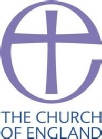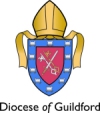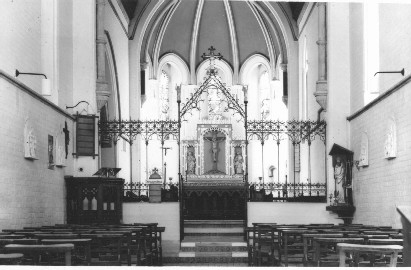© Parish of Hawley 2021



This picture of the interior of All Saints' was probably taken in the 1970's
This history has been gathered from a leaflet compiled and printed in 1973 by Mr L C Last. He in turn was indebted to information provided by the then incumbent of Hawley the Revd. Garth Long.
The "old" All Saints' was deconsecrated in 1976 partly due to a population shift in the Farnborough area, and also the need for major building renovation requirements. It's place was taken by the new All Saints’ Church and Centre which is approximately 1/2 mile further down Fernhill Rd, nearer to a major housing conurbation.
The building still exists but is unused. The external features are unchanged except the bell has been removed. Some of the stained glass windows are still in place, however their colour is difficult to discern due to internal building changes. Sadly little of the interior described in this history still exists. It is still possible to see two marble columns, the altar step and the blue sanctuary roof.
The following is the text of a leaflet made available to visitors to the church in the 1970's
We in Hawley are more than pleased to share our little building with all who visit us. The walls of this living church echo with the voices of those who have worshipped here, and the footsteps of those who have passed through its doors since they first opened in 1881. Spare a thought for those who have gone before you, and by whose industry and love, this building was created, and kept alive over the years, so that you dear visitor can enjoy its beauty. Rest awhile in peaceful surroundings and share with us the joy of this place.
This Short History and Guide to the church has been compiled so that you may see and enjoy a few of the interesting features that may otherwise go unnoticed.
We hope you will enjoy your visit to our little church, and that you will come back again sometime.
L C. Last August 1973
All Saints' Church - Hawley A brief history
In 1881 Mr. Charles Randell of Fern Hill, Hawley, (a cousin of the Revd. John Randell who was the founder of Holy Trinity Church, Hawley), built and endowed All Saints' Home (now Randell House) and also founded a Chapel - now known as All Saints' Church.
The Home was intended as a convalescent home for the people of a parish in East London, but before it was completed Charles Randell died. The Home and Chapel were completed in 1882 by his widow Eden Randell in his memory, and the Community of St. John Baptist, Clewer, under the guidance of Canon T.T. Carter, their founder, undertook to run the Home as a home for girls and young children from the slums of London who were without homes of their own, or "exposed to evil influences".
All Saints' continued as a home for children until 1937 when it became a house of Rest and Prayer for ladies. The home closed for a short time at the outbreak of the Second World War in 1939, but reopened the following spring. In 1953 All Saints' Home was handed over to the Royal United Kingdom Beneficent Association who modernised and enlarged it, and the following year the Sisters of the Clewer Community left to return to their Mother House at Clewer, near Windsor.
Although All Saints' Church was the chapel of the Home, it was always open to the public and there was a close link with the parish of Hawley. The Vicar of Hawley was normally a member of the Home committee.
All Saints' Church was officially handed over to the Church Commissioners in March 1955 and consecrated by the Bishop of Guildford on the 8th May the same year.
The Church was designed by Mr. Arnold Hoole (who also designed the tower and Spire of both Holy Trinity Church, Hawley, and St. Michaels Church, Yorktown (Camberley). The building consisting of the nave, apsidal chancel and sanctuary was completed on the 25th March 1882 -Lady Day - and dedicated by Bishop Harold Browne on the 13th May, of that year.
In 1890 the sacristy was added and the work paid for by Mrs. Randell. In 1902 the porch was built by Mr.J.C. Randell - nephew of Mrs. Randell - and in 1924 the Chapel of the Blessed Sacrament, designed by Mr. Cecil Hare, was erected. The stone crucifix on the exterior of the east wall of the Chapel, was added a year later. NB (This still exists)
The church is built of red brick, and the chancel and nave are covered by a timber barrel roof with a tiled exterior. Originally there was a small bell tower constructed of timber, situated above the east end of the nave. The bell tower became unsafe over the years and in 1955 it was removed and the bell rehung above the west door of the nave where it Is today.
The Stained Glass windows and other features:
On entering the outer porch, a brass plate fixed to the left hand wall reads:
To the Glory of God
The undermentioned works were given
as thank - offerings
by John Charles Randell of Hawley, Blackwater.
Exterior Porch Chancel Screen & Gates
with
alterations to Chancel floor.
Through the west door of the church and on the west wall to your left is a brass plate bearing the inscription:
+In Peace +
Charles Randell of Fern Hill, Hawley,
died at Palerma, Feb.22nd. 1881 aged 66
"Therefore are they before the throne of God
and serve him day and night in his temple"
To the glory of God and in loving memory
of her husband, this Chapel and Home
of All Saints were completed
Lady Day 1882
+ + +
Above the west door is a beautiful stained glass rose window by Clayton & Bell. In the centre of the window is the Lamb of God supporting a banner on which the words "Ecce Agnvs Dei" can be seen. This central figure is surrounded by eight angels and four pairs of cherubs. The lower angel is holding the inscription "WORTHY IS THE LAMB THAT WAS SLAIN"
Turning now to the north wall of the nave, the first window shows the figure of St. John Baptist carrying a cross and banner bearing the inscription:
"MIGHTIER THAN I"
The plaque beneath this window reads:
This window is erected
to the glory of God
and in loving memory of
John Charles Randell
Born September 4th 1853
At rest December 1st 1909
"Grant him 0 Lord Eternal rest
and let perpetual light shine upon
Him"
The second window is of St. Mary B.V. holding the holy babe in her left arm, and a lily in her right hand. The plaque beneath reads:
To the Glory of God
and in memory of
Eden Randell
who departed this life on April 19th 1906
and who with her husband Charles Randell
founded the home and chapel.
This window is erected by her nephew
J.C.Randell and other younger members of
her family in conjunction with some old
friends and servants.
The third window shows the figure of Christ holding a lamb in his left arm, and carrying a shepherds crook in his right hand. The inscription reads:
I AM THE GOOD SHEPHERD
The letters IHC can be seen in the small window above.
There are two memorial plaques beneath the window of the Good Shepherd, the first one reads:
To the Glory of God
and in loving memory of
John Cruttenden Mace
Chaplain of this home from 1900 to 1906
when, on April 18th he fell asleep.
And of his son
Christopher Waterman Mace
April 24th 1908 aged 28
"GRANT THEM A PLACE OF REFRESHMENT,
LIGHT AND PEACE"
The second plaque reads:
To the memory of our mother
Mary Ellen Mace
who entered into life Sunday June 25th 1911
REQUIEM AETERNAM DONA EI DOMINE ET LUX
PERPETUM LUCEAT EI
+ + +
Looking back to the south wall of the nave, the first window as we come in shows St. Margaret holding a spear in the act of killing a dragon. Note the unusual colouring of the dragon as if the artist has tried to reduce its fierce appearance by using many colours. In this creature can be seen yellow, purple red, orange, green and blue.
The second window in the south wall is of St. Faith, holding a wooden cross in her right arm, and a book in her left hand.
Beneath the second window is a memorial plaque to two brothers killed in the first World War. The memorial reads:
In loving memory
Ian Herbert Sydney Jameson
Captain 8th Seaforth Highlanders.
Born April 23rd 1888
killed in action at Guemappe France
April 23rd 1917
And his brother
Harry Roderick Victor Jameson
2nd Lieut. 2nd Seaforth Highlanders.
Born August 29th 1897
killed in action at Fampoux France.
April 11th 1917.
"I Believe In God"
The third window is perhaps the most interesting one in this small church, for although it depicts St. John Evangelist holding a bible and chalice, the face is a facsimile of Canon T. T. Carter, founder of the Clewer Community, and who attended the dedication of the chapel in 1882.
The inscription at the bottom of the window reads:
"D.G. Inmemoriam Thomas Thellusson Carter
Priest R.I.P. 1901"
Continuing into the chancel the first window on the south wall is of St Charles Borromeo - Bishop and Cardinal. In his left hand he holds a cross and his right hand is raised in blessing. A very colourful window this with the Cardinal dressed in a crimson cloak trimmed with gold. Note also the Cardinals hat and the red gloves.
The second window in the chancel is that of St. Cecilia and she is shown holding in her left arm a small pipe organ - her emblem as patron saint of musicians.
A brass plate on the wall between the two windows reads:
"To the glory of God and in memory of
loved ones at rest in Christ.
These windows are dedicated".
These two windows together with the choir stalls were presented to the Chapel in 1893 by Mrs. Randell.
There are five windows in the Apse, two of which have plain glass and it is believed that they originally contained stained glass but that this was removed in order to gain more light within the sanctuary. Reading from the left, the second window contains the figures of six men and two women. One man is holding a knife and censer, one man (Moses?) is holding a tablet bearing the Roman numerals III, IV, & V. There are also in the window two angels -one playing a lyre and the other twin pipes.
The third window (centre) shows the ascended Christ wearing a crown and seated on a throne. His hand is raised in blessing.
The fourth window contains five men and two women. One man is holding a model of a church, another is playing a lyre. One man is holding two measuring rods, and one is carrying a small coin bag. Two angels are included in this window, one is playing the cymbals and the other a stringed instrument.
The carved wooden Reredos behind the altar was designed by Cecil Hare, and was erected in 1931 in memory of Sister Mary Cecilia who had spent nearly all her life as a Sister at Hawley. She was Sister in charge of the Home from 1922 to 1930. There is an inscription to the right of the reredos which reads:
+ Pray for the soul of Sister Mary Cecilia C.S., J.B. who died on the feast of St Phillip & St.James 1930. This Reredos was given by her relatives, friends and "Old Girls" as a Thank-offering for her life.
LAUS DEO
The Organ was given to the church in 1886 by Thomas Dyer Edwards of Waverley Court, Camberley, in thanksgiving for the recovery of his wife from a serious illness in the autumn of the year 1884.
The Chancel Screen was presented to the church in the year 1890 by J.C. Randell. Behind the Rood can be seen a small brass plate which reads:
R.I.P.
Louisa Mary Stepney
April 1st 1939
The five carved figures in the front of the altar represent the four Doctors of the Church and the central figure is of the Blessed Virgin. Details of these figures are given on page 12.
Around the Sanctuary arch facing west, can be seen seven sets each of five marks. These marks are where the seven sanctuary lamps used to hang, now long since removed.
At the apex of the east side of the Chancel arch can be seen the hole in the roof through which the rope to ring the sanctuary bell used to pass.
The bell was moved to the west end of the nave when repairs to the roof were carried out in 1955. The wear marks made by the bell rope against the face of the arch can be clearly seen.
To the visitor the absence of a font will have been noticed. In this Church of All Saints' a portable font is used at Baptisms. The original stone font (which was also portable) was discarded some years ago, and replaced by a silver bowl. The remains of the original font can be seen outside the church at the east end entrance to the Lady Chapel.
The figures in the Altar
There are five figures in all, carved in oak. They represent the four Doctors of the Church and the fifth is of Our Lady and the Holy Child.
From left to right, the first figure is that of St. Augustine of Hippo, and is shown with a burning heart. St. Augustine was born at Numidia in 354 and died at Hippo in 430. He was Bishop or Hippo and for 34 years was one of the greatest bishops in the history of the Christian Church in a diocese of North Africa.
The next figure is of St. Gregory the Great and he is shown wearing a triple tiara. He is also carrying a staff and book. St. Gregory was the first and greatest of sixteen Popes named Gregory, and is accounted the fourth of the great Latin doctors of the church. He was born in Rome in 540 and died there in the year 604.
To the right of Our Lady and Child, is the figure of St. Ambrose holding a beehive. Born at Trier between 334 and 340, he was made Bishop of Milan in 374. He was the first teacher in the West to make extensive use of hymns as a popular means of divine praise. He died at Milan in 397.
The last figure is that of St. Jerome, the most learned of the Latin fathers of the church and among the greatest of biblical scholars. Practically the whole of the Latin Bible was either translated from Hebrew and Greek or worked over by him. He is shown holding a bible and a model of a church. In art, he is often shown accompanied by a lion, and represented with a cardinal's hat, because of his service to Pope Damasus. St. Jerome was born in Dalmatia in 342 and died at Bethlehem in 420.
Chaplains of All Saints' Home
1881 W.M. Roberts 1946 F.E. Pearse
1900 J.C. Mace 1947 W. Linton
1906 L.C.K G Greenway 1948 W Dudley Dixon
1932 C. Brook 1951 H.J. Hawkins
1935 A.C Scott
Assistant Curates at All Saints'
1953 - 1955 Ronald Crowther
1955 - 1958 Cyril Sackett Hope
1958 - 1966 Raymond Geoffrey Skinner
1966 - 1968 David Thomas Whitehorn Salt
1970 - 1974 Peter Lionel Bodycomb
A Prayer for the Church
0 God, our Shepherd, give to the Church a new vision and a new charity, new wisdom and fresh understanding, the revival of her brightness and the renewal of her unity; that the eternal message of thy Son, undefiled by the traditions of men; may be hailed as the good news of the new age;
through him who maketh all things new,Jesus Christ our Lord.
Amen

The History of the "old" All Saints' Church, Hawley

| Baptisms |
| Weddings |
| Funerals |
| HAMS |
| Mothers' Union |
| Bellringers |
| Trinity Hall |
| All Saints' Hall |
| Holy Trinity |
| All Saints' |
| Family History |
| Harriet Wyatt |